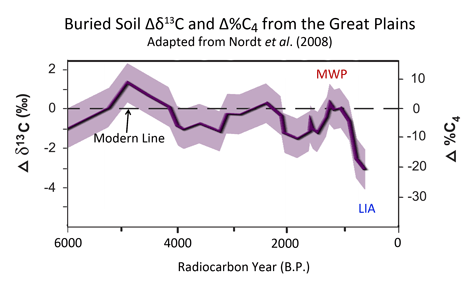North American Great Plains, USA
Reference
Nordt, L., von Fischer, J., Tieszen, L. and Tubbs, J. 2008. Coherent changes in relative C4 plant productivity and climate during the late Quaternary in the North American Great Plains. Quaternary Science Reviews 27: 1600-1611.
Reference
Nordt, L., von Fischer, J., Tieszen, L. and Tubbs, J. 2008. Coherent changes in relative C4 plant productivity and climate during the late Quaternary in the North American Great Plains. Quaternary Science Reviews 27: 1600-1611.
Description
Based on isotopic soil carbon measurements made on 24 modern and 30 buried soils scattered between latitudes 48 and 32°N and longitudes 106 and 98°W (average of 38.93°N, 101.99°W), Nordt et al. developed a time series of C4 vs. C3 plant dynamics for the past 12,000 14C years in the mixed and shortgrass prairie of the U.S. Great Plains; and because the percent soil carbon derived from C4 plants "corresponds strongly with summer temperatures as reflected in the soil carbon pool," as they describe it, they were able to derive a history of the relative warmth of the region that indicates that the peak warmth of the Medieval Warm Period was slightly greater than it has yet to be during the Current Warm Period.





